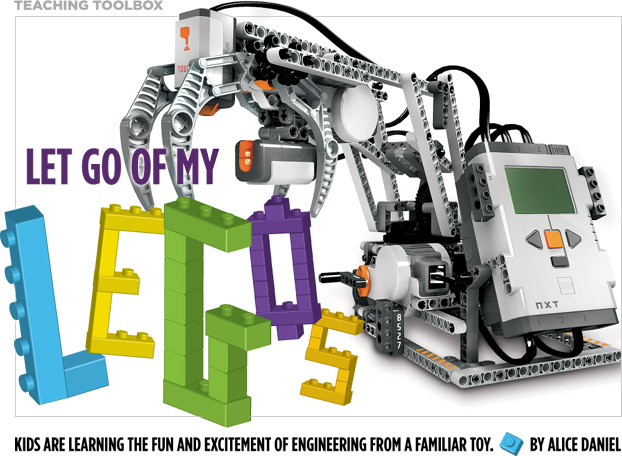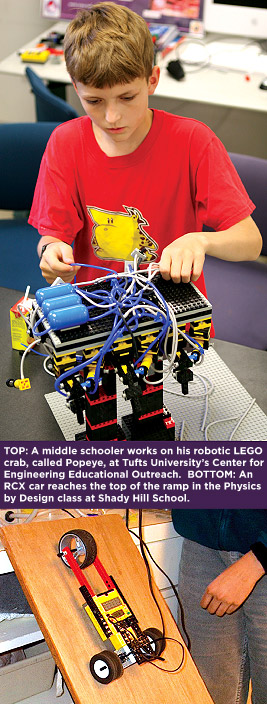g
The eighth-grade Physics by Design class at the Shady Hill School in Cambridge, Mass., has a reputation for being downright fun. But most students don’t refer to it by its conventional title, they just call it Lego. That’s right. Lego. You won’t find students here nodding off to sterile terms in a textbook; instead, they’re elbow-deep in bins of colorful plastic bricks building cars and movable robotic arms. And because they’re learning to program whatever they build with the help of Robolab software and a microcomputer embedded in a Lego brick, they really understand the meaning of torque, velocity and momentum.
Teacher Barbara Bratzel started offering the Lego class at Shady Hill eight years ago as a way to teach students engineering in addition to science. “It really grabs kids and you can do a lot of serious projects with it,” she says. “Students gain so much confidence in themselves as problem solvers,” and many, who might not have viewed themselves as gifted in math or science, soon discover they have a keen spatial sense or strong building skills. Bratzel, who is one of the country’s Robolab pioneers, loved developing the curriculum for her class so much that she wrote a book called “Physics by Design: Classroom Tested Activities Using Robolab and Lego” (published by College House Books, Nashville, Tenn.).
“Robolab is all icon-based, and the data structures they’re learning are the ones they use if they go on and take programming,” Bratzel says. Students first learn to program simple cars using the microcomputer brick. Because the microcomputer has motors and sensors, a student can learn to make a car spin, follow a curve, go as slow as possible or even navigate an obstacle course. As the year progresses, the class gets more complicated. The final project last spring was to make a sensory-triggered contraption that would take a raw egg out of a nest on a table, carry it safely down to a plate on the floor and then reset itself. If the egg broke, students went back to the drawing board, or in this case, the computer, to figure out what went wrong.
Amelia Piazza, who took the class last year, said she liked the process of learning physics theories and then sifting through bins of Legos to find the right bricks, pulleys or levers for that week’s project. For the egg contraption, she and her lab partner used a pulley, an inclined plane and a touch sensor. “We spent class after class on it, building and looking for errors in the program. Sometimes it worked and sometimes it didn’t. One time the entire thing fell off the table and smashed.”
Piazza relates the class to the trials and errors of engineering in this way: “If you think about someone who’s an engineer, they build a machine that will do something. The two of us built this machine that takes an egg from a table to a floor. Say you do that 6,000 times an hour; by speeding it up and making it smaller, that’s a machine that can be used in a factory.”
That degree of comprehension and enthusiasm for engineering among elementary and middle school students is one goal of the Center for Engineering Education Outreach (CEEO) at Tufts University. But inherent in that goal is getting teachers interested in engineering education. “Most elementary teachers don’t have an engineering background,” says CEEO Director Chris Rogers. “It’s easy to show engineering’s a powerful way to teach math and science—it’s harder to convince someone to actually change the way they teach.” With that in mind, Rogers worked with the Lego company and other engineers to create a tool set that would inspire teachers and students. Rogers designed the Robolab software, while engineers at the Massachusetts Institute of Technology created the microprocessor. The tool set is marketed as Lego Mindstorms, but most students just refer to it as Robolab. “It’s great because Lego is so well known. Kids love it and the robotic side makes it come alive,” Rogers says.
Robolab has been translated into 16 languages and is in about 35,000 schools worldwide, more than half of which are in the United States. But Rogers would like to see a systemic change similar to the one in Massachusetts, which requires engineering to be taught in elementary schools. One way of galvanizing teachers to take Lego robotics back to the classroom, he says, is by building a support network: CEEO offers Lego Engineering Conferences for teachers in the summer and a Web site that provides a slew of grade-sensitive curricula. Diverse activities teach first and second graders fractions and decimals, fifth graders fluid mechanics and college kids advanced control theory. “The tool set has virtually no ceiling,” Rogers says.
There’s no doubt that Robolab is a sophisticated product. Rogers created it with the help of a National Instruments programming tool called LabVIEW, which has great relevance in the scientific world. Scientists and engineers use LabVIEW to measure and automate everything from automobiles to the Mars Pathfinder. In 2004, Lego asked National Instruments to develop the next generation of Mindstorms, incorporating even more of LabVIEW’s advanced technology. The new product, called Mindstorms NXT software, is being integrated into schools this year and is compatible with Robolab. The difference is a software interface that is much simpler to program, says Ray Almgren, vice president of National Instruments’ product marketing and academic relations. The result is a younger target age of 8. “We’ve added about two more years to the target age,” Almgren says, and younger kids can easily learn the icon-based drag and drop software. With the new product, Lego gets an industrial-strength product and a tool it can promote as being even more relevant to engineering, he says.
Lego Learning
Certainly, promotion of the product’s relevance to teaching science and engineering is a big part of getting teachers to participate. CEEO has a Student Teacher Outreach Mentorship Program (STOMP) that places undergraduate and graduate engineering students in classrooms to facilitate engineering education. Bill Church, a teacher in Littleton, N.H., was inspired by STOMP and decided to train his high school students in the same capacity. Church had been using Robolab for years in his classes and realized that his students, who could program robots to play soccer, solve mazes or do image analysis with a web camera, could also learn from teaching the program to elementary school teachers. Plus, it was another way to instigate service learning in his small community.
Trying to change the way schools operate is like changing the tire on a car going 65 mph, Church says. In other words, the system is moving. “If teachers are always on the move, there’s no time to pull them out and train them with new ideas,” he says. That’s why it works if mentors come on board and train teachers in the classroom. Teachers are more willing to take a risk and teach Robolab if there’s some continual classroom support, Church says.
Teaching with Lego robotics demands a certain curiosity and enthusiasm for learning. “It’s more than sitting around doing worksheets,” Rogers says. “It is definitely teaching through chaos.” Retired first-grade teacher Sue Ann Kearns agrees. Ten years ago, she took a teacher-training class on Lego engineering at Tufts and initially equated the experience to reading Greek. Even when she began to grasp terms like pressure and torque, they somehow didn’t seem applicable to her first-grade class at Lincoln Elementary School in Lincoln, Mass. “Within two hours of the class, I was lost!” she says. “I couldn’t figure out how I was ever going to integrate this information, much less understand it myself.” But that was before she heeded the advice of Rogers, who told her that first graders were natural engineers and to just let them build.
Despite her early trepidation, Kearns is a strong proponent of Lego in the schools and says she was amazed at what first graders could do. “They would often figure out gear ratios before they were even introduced!” she says. The hands-on activities were ideal for all abilities in the classroom and gave students a chance to work together. “Many of my academically challenged students would shine,” she says. “They could envision what their project was going to look like and could hardly wait to get to work.”
Such a sentiment is not uncommon. Phil Reitz, a technology education teacher at Fuller Middle School in Framingham, Mass., runs a weekly Lego Robotics club for an after-school remediation program. Robolab is user-friendly, he says, allowing students who are at a lower reading level to work with kids who aren’t. Even if a student doesn’t always understand the engineering design process, he can still do some amazing, creative things, Reitz says. One student, for instance, built a Lego arm that could pick up an object. But the arm was big and bulky so Reitz gave the student a newsprint tube and asked him to build an arm that would fit in it. “He got so excited. He had solved this other problem and now he was excited about trying to solve this one,” Reitz says. “And he did it!” Students begin to understand that everything they touch has been engineered. “If a kid’s interested in animals, it doesn’t mean he has to be a vet. He can design the next prosthetic device that will hold up a horse in rehab.” Or, in the case of Reitz’s student, the next prosthetic arm.
It is that notion of succeeding by trial and error, of creating something within certain parameters, that seems to enthrall students. “The great thing about the Lego class,” says former Shady Hill student Amelia Piazza, “is it’s the most hands-on I’ve ever had and hands-on is the best kind of learning in my opinion. It’s the most fun.”
Alice Daniel is a freelance writer based in Fresno, Calif.
Category: Teaching

